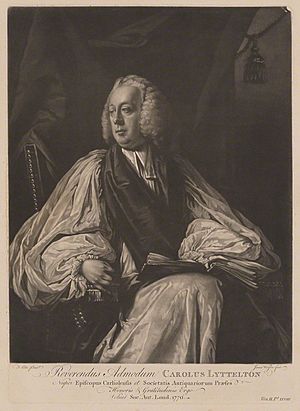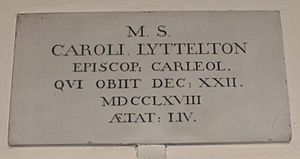Charles Lyttelton (bishop) facts for kids
Quick facts for kids Charles Lyttelton |
|
|---|---|
 |
|
| Diocese | Carlisle |
| In Office | 1762–1768 |
| Predecessor | Richard Osbaldeston |
| Successor | Edmund Law |
| Orders | |
| Ordination | 1742 |
| Consecration | 21 March 1762 |
| Personal details | |
| Born | 1714 Hagley, Worcestershire, England |
| Died | December 22, 1768 (aged 53–54) London, England |
| Buried | St John the Baptist Church, Hagley |
| Denomination | Church of England |
| Parents | Sir Thomas Lyttelton, 4th Baronet (father) |
| Alma mater | Eton College, University College, Oxford |
Charles Lyttelton (1714–1768) was an important English church leader and a keen historian of old things, known as an antiquarian. He was a member of the famous Lyttelton family. From 1762 to 1768, he served as the Bishop of Carlisle, a high position in the Church of England. He was also the President of the Society of Antiquaries of London from 1765 to 1768, a group dedicated to studying history and old objects.
Contents
Who Was Charles Lyttelton?
Charles Lyttelton was born in 1714 in Hagley, Worcestershire, England. He was the third son of Sir Thomas Lyttelton, 4th Baronet. His mother was Christian, daughter of Sir Richard Temple.
His Education and Early Career
Charles went to Eton College, a famous school. Later, he studied at University College, Oxford. He finished his law studies in 1738. However, he soon decided to join the church instead. He became a priest in 1742.
In 1743, he became the rector (head priest) of Alvechurch, Worcestershire. His family had a lot of influence. This helped him become a chaplain to King George II in 1747. A year later, he became the Dean of Exeter. This meant he was in charge of Exeter Cathedral.
While at Exeter, he worked hard to improve the cathedral library. He made sure its more than 6,000 books and old handwritten documents were cared for. He also organized the church's historical records.
Becoming a Bishop
In 1761, his cousin, George Grenville, helped him get a promotion. Charles Lyttelton became the Bishop of Carlisle. He was officially made bishop on March 21, 1762. Sadly, his health was not good. He passed away in London on December 22, 1768. He was buried at St John the Baptist Church, Hagley. He had paid to decorate the church's chancel in 1764.
What Did Charles Lyttelton Do?
Charles Lyttelton was very interested in history and old things. He became a member of the Royal Society in 1743. This is a group for important scientists. In 1746, he joined the Society of Antiquaries of London. This group studies ancient objects and history. He became its President in 1765.
His Contributions to History
He wrote articles for important academic journals. These included the Philosophical Transactions and Archaeologia. These journals published new discoveries and research.
Historians like Rosemary Sweet say that Charles Lyttelton was very important. He helped start the careful study of old buildings. He was especially interested in Gothic architecture. This is a style of building with pointed arches and tall windows. He helped people understand how important these old buildings were to history.
His Lasting Impact
Many other historians and scholars respected Charles Lyttelton.
- William Borlase dedicated his book about Scilly (1758) to him.
- Andrew Ducarel dedicated his work on Anglo-Norman history (1767) to him.
- Samuel Pegge wrote an essay about ancient coins for him.
His Collection of Manuscripts
Charles Lyttelton left his valuable collection of handwritten documents to the Society of Antiquaries. These documents were very useful for later historians.
- They helped Treadway Russell Nash write his History of Worcestershire.
- They were used to improve Sampson Erdeswicke's Survey of Staffordshire.
- Stebbing Shaw also used them for his History of Staffordshire.
Lyttelton also encouraged a young man named Samuel Hellier to study music. Hellier later became very passionate about music.
Studying Old Buildings
Charles Lyttelton's notes on churches and other old buildings are very important. He was one of the first to study Saxon architecture and Gothic architecture in a detailed way. He pushed the Society of Antiquaries to publish drawings of what he thought were Saxon buildings. He also supported making engravings of illustrations from the Caedmon manuscript. This was because they showed Saxon building styles.
Some of his drawings of Saxon churches are now being digitized. They are part of the Conway Library at The Courtauld Institute of Art.


